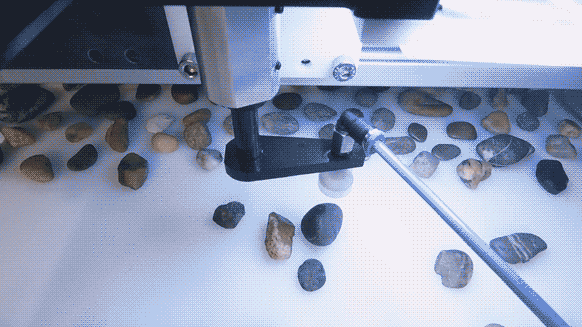The Iller river stretches for 91 miles through southeastern Germany before meeting up with the Danube. This river, like all rivers, is filled with sediment--- rocks and pebbles from thousands of years ago that sit on the riverbed and along the bank. One day last year, Benjamin Maus was lounging near the Iller admiring a handful of pebbles. “I was basically just sorting pebbles and spraying them with sunscreen, which made the colors much more vivid,” Maus recalls. At the time Maus, an artist, had no clue that these pebbles would inspire his latest work. Maus is known for his technologically focused creations, and pebbles are about as analog as you can get.
Then late last year, Maus decided to collaborate on a project with longtime friend and fellow artist Prokop Bartoníček. The two have long been interested in industrial automation and its effects on society. They wondered if they could create a piece that was simultaneously technically impressive and functionally useless. The pebbles came to mind.
The result is Jller, an installation that Bartoníček describes as a “very complex machine that’s doing nothing very special.” Jller's main task is sorting pebbles from the Iller river into neat, organized rows. It's able to do this by using machine learning, computer vision, and an industrial-grade vacuum-gripper. Without any help from a human, the robotic arm analyzes each of the 7,000 stones and sorts them according to type and age. “We’re kind of creating a machine that processes nature in a way," says Maus.
To start, Maus manually trained a machine learning algorithm to recognize features in 30 different types of stones.The stones are categorized based on two metrics---the computer vision camera is able to determine both the dominant colors in the stones and the structural histogram of the rocks, or in other words the grains, lines, patterns, surface texture of the rocks. Both features give clues to how old the stone is.
At the beginning of every run, the camera takes a photo of the randomly assorted rocks and uses it to map the location of each stone. “By doing this we can be quicker in rearranging, because we don’t have to do it blindly,” says Maus. The robotic arm then gets to work, suctioning the stones and placing them down according to age and type, though the artists say that the algorithm is capable of producing all forms of patterns. The process takes two to three exhibition days.
Watching the robotic arm at work is oddly transfixing---it’s almost soothing in its methodical precision. The artists say they’re not surprised when people tell them watching the piece is meditative. "We all have this inside us---we like to collect, we like to measure, we like to move things,” Bartoníček says. "This need to collect things and sort them is really one of the most elemental points where we humans start to be humans.”

